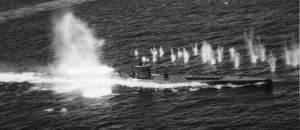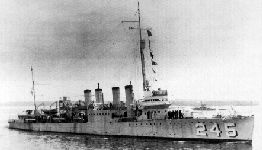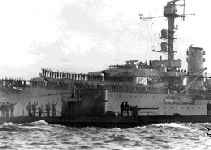
German U-Boats in the
Battle of the Atlantic was the longest battle of the Second World War, beginning from the first day of hostilities and ending on the very last day of the war. It was also the most important battle during the entire Second World War because the success of every other campaign in every other theater of war depended upon its success. Many experts agree that defeat of the German U-Boats and control of the shipping lanes linking the Allied nations of Great Britain, United States and Canada was a key factor if the Allied nations were to invade occupied Europe and the heartland of Germany itself.
The Battle of the Atlantic was not about the most powerful navy; neither was it about glorious battles fought between battleships and submarines. But the Battle of the Atlantic was a commerce war waged by German U-Boats against Britain’s merchant marine. For nearly six years, Germany launched over 1,000 U-Boats into combat, in an attempt to isolate and blockade the British Isles, thereby forcing the British out of the war. It was a fight which nearly choked the shipping lanes of Great Britain, cutting off vital supplies of food, fuel and raw materials needed to continue fighting.

|

|
| The USS Reuben James, seen here on March 9, 1932 on her recommissioning in Philadelphia. She would be the first US warship sunk by a U-boat.
|
U-47 commanded by U-boat ace Gunther Prien, receiving a salute from a German Cruiser after returning from Scapa Flow.
|
| Did you know? |

|
The Type VII U-Boat was not the best submarine in any particular aspect, but it was the most successful of the war...

|
|
|
By the end of the war,
German U-Boats in the
Battle of the Atlantic had sent over 2,900 ships and 14 million tons of Allied shipping to the bottom of the sea. In exchange, the Allies sank almost 800 U-Boats and over 30,000 of the 39,000 German sailors who put to sea, never returned – the highest casualty rate of any armed service in the history of modern war.
During the early war, German U-Boat successes against British and American shipping were so remarkable, that on January 1943, the Allies issued a decree in Casablanca which made the defeat of German U-Boats a number one priority. Winston Churchill, the then Prime Minister of Britain was most noted in his speech summarizing the German U-boats and the Battle of the Atlantic as "The only thing that ever really frightened me during the war was the U-boat peril".
Grand Admiral Karl Donitz, commander of the German U-Boat force understood the potential of the submarine’s unconventional ability, and believed Germany could fight a naval power like Great Britain, and win. He was the only officer in the German High Command who viewed that victory in the Battle of the Atlantic could only be achieved by German U-Boats, and such a victory would lead to an early conclusion of the Second World War. Others did not share his view and held the notion that big guns and the unsinkable battleship was key for control of the high seas.
In fighting for supremacy in the Battle of the Atlantic, the Admiral was proven right, as the super battleships of Germany such as the Bismarck and Graf Spee had only made headlines as being hunted down and sunk by the Royal Navy, while the German U-boats continued to inflict heavy losses on Allied shipping. The most famous element of the Battle of the Atlantic was the “Wolf Pack”, or Rudeltaktik as the Germans called it. It had brought such devastation on the high seas and was based mainly upon the works of the Admiral.
On these pages, you will learn about the History of the Battle of the Atlantic, and the role German U-boats played during the war. From the pre-war period of the Polish crisis, to the triumphs of the German U-boats, to the technological advances which turned the tide and led to the ultimate defeat of the U-boats in the Atlantic.
The Historical Overview on the left showcases the tactics, famous submarine battles, the people, awards, and the articles section features many interesting facts about German U-boats. Find what it was like living on board a U-boat, escape procedures from a sunken U-boat and many, many more in the articles section.
The second section is the U-Boat Reference which portrays technical details of the submarines and their weapons and equipment. All major technical aspects of German U-boats is covered here, including the submarine types, the electronic warfare equipment, midget submarines, and human torpedoes fielded during the Battle of the Atlantic.
Finally, you can subscribe to our newsletter to receive an exclusive Eighteen Part Special Report about German U-Boats and the Battle of the Atlantic. If you have an interest in submarines, and I believe you do, then you will find this report to be very unique and informative.
Not available anywhere else, not even on this website, these reports are emailed to you weekly. Here are some of the articles :-
- Introduction to the Type VII U-Boat
- Exploring Inside the Type VIIC
- The Techniques of U-Boat Replenishment at Sea.
- U-boat Insignias During the War.
- How a Destroyer Makes a Depth Charge Attack.
- Submarine Decoys.
- How a German U-Boat Arrests a Steamer.
- German CO Suicides at Sea.
- Admiral Karl Donitz.
- The Submarine as a Mine Layer.
- Unrestricted Submarine Warfare.
- Radar in the Electronic Battlefield.
- And much, much more.
| Only Available To Subscribers |
|
|
|
Rest assured, there is no spam to worry about. We hate spam with a passion, and your email will never be released to any third party and you can opt out anytime.












